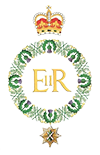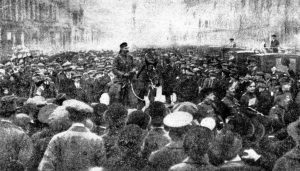THE RAISING OF 16th BATTALION THE ROYAL SCOTS (McCRAE’S)
Sir George McCrae, born in Aberdeen, was a self made Edinburgh business man, who made his mark in the drapery trade. He became a member of Edinburgh Council in 1889. He was the City Treasurer and Chairman of the Finance Committee from 1891-1899 and also served as a Justice of the Peace. In 1899 the sitting MP for Edinburgh East died leading to a by-election. George McCrae was selected as the Liberal candidate and held the seat for that party. In 1909, after a successful career as an MP, he resigned from the House of Commons to take up a senior position in Scottish government service as Vice-President of the Local Government Board.
George McCrae had always wanted to be a soldier but ambition was in direct competition with his growing success in business. In parallel with his civic and parliamentary life he played a prominent role in the City’s Volunteer and, from 1908, Territorial Force. At the age of 18, he had joined the 3rd Edinburgh Rifle Volunteers as a Private. The Battalion was re-titled the 4th and, later, the 6th Battalion The Royal Scots, under both of which names McCrae, now a Lieutenant Colonel, proved to be a highly successful and popular Commanding Officer. He was closely consulted, both as an MP and a senior Volunteer Officer, by Richard (later Lord) Haldane over the creation of the Territorial Force following the failings highlighted in the Boer War. For his services to Volunteering and to Edinburgh he was knighted in 1908. In June 1913, six months before his wife’s death from cancer, and by now a full Colonel, he resigned from command.
On 5 August 1914, the day after the Declaration of War, Field Marshal Lord Kitchener, who happened to be the Honorary Colonel of 6RS – McCrae’s old battalion – was appointed Secretary of State for War. He immediately set about expanding the Army with an initial call for 100,000 volunteers to form the first of his ‘New Armies’. For The Royal Scots this led to the raising of three Service Battalions, the 11th, 12th and 13th all by the end of August.
The first days of the war, as the British Expeditionary Force (BEF) mobilised and moved to France, coincided with the opening of the Scottish football season. A number of Clubs had argued for delay, and even abandonment, until the position was clearer, but the majority voted to continue while providing recruiting facilities at their grounds. This view was supported in a statement from the War Office at the end of August ahead of the start of the English season. By this time, however, the BEF was in full retreat from Mons and had suffered very considerable casualties. A vociferous campaign began against the continuance of professional football at such a time of national crisis and, in particular, the fact that the players themselves were not leading the campaign by volunteering to serve. In mid-November the War Office finally changed its position in a letter published in The Glasgow Herald in which Harold Tennant the Under-Secretary for War, was quoted as saying ‘No objection is taken to occasional recreation. It is considered, however, that (league) football does not come within that category. It is much more desirable that professional footballers should find employment in His Majesty’s forces than in their old occupation’. The die was cast, football was definitely on the back foot and the ‘stoppers’ as they were called stepped up their campaign for the game at that level to be cancelled and conscription be brought in. Enter Sir George McCrae.
From soon after the declaration of war Sir George had been heavily involved as Scottish chairman of The Prince of Wales’s Fund for the relief of Wartime Distress. Three of his sons were serving, one as a Company Commander in 6RS, but he was conspicuous in not becoming directly involved in recruitment. Early in November, with increasingly bad news coming back from France, Sir George wrote a personal letter to his old friend Harold Tennant offering to raise a battalion, provided he was allowed to lead it in the field and to share the risks of those who volunteered to join him. On 17 November he received approval for his proposal and was reappointed to the rank of Colonel. A keen supporter and Director of Heart of Midlothian, one of the two major Edinburgh football clubs and known to everyone as Hearts, Sir George realised that, if he could get some players to join his battalion ‘such a happening would ensure a mighty following and a quick formation of the unit’. Having secured the names of 11 players, six from the first and five from the second team, he announced on 24 November that formal recruiting would start with a grand meeting in the Usher Hall at the west end of Edinburgh on the evening of Friday 27th November. After hearing from a number of speakers, and the unanimous passing of motions supporting recruiting and, in particular, that for Sir George’s proposed Active Service Battalion of The Royal Scots, Sir George himself rose to speak saying:
‘This is not a night for titles: I stand before you humbly as a fellow Scot, nothing more and nothing less. You know I don’t speak easily of crisis. But that is what confronts us. I have received permission from the War Office to raise a new battalion for active service. It is my intention that this unit will be characterised by such a spirit of simple excellence that the rest of Lord Kitchener’s army will be judged by our standard. Furthermore, with the agreement of the authorities, I have undertaken to lead the battalion in the field. I would not – I could not – ask you to serve unless I share the danger at your side. In a moment I will walk down to Castle Street (the local recruiting office) and set my name to the list of volunteers. Who will join me?’
With that he strode from the Hall and down to the Recruiting Office followed by most of those in the Hall. By midnight nearly 300 had enlisted. Within seven days, over 800 men had signed up for what would become 16RS but was always better known as McCrae’s Battalion. That Saturday they paraded behind Sir George, still in civilian clothes, around Tynecastle, the Hearts ground, at half-time in the local derby match against the other major Edinburgh team, Hibernian or Hibs. By the following Saturday, when the Battalion paraded through the City en route to George Heriot’s School which was to be their initial barracks and training base, the total had risen to over 1350 including a strong contingent of professional and amateur footballers and other sportsmen. A total of at least 30 professional footballers are listed as having joined. These included, in addition to the original 11 plus, now, two further professionals from Hearts, taking the total to thirteen, seven from Raith Rovers, six from Falkirk, two from Dunfermline Athletic and one from Hibs. Seventy-five football clubs are listed as having contributed members to 16 RS by December 1914.
The campaign to cancel all football matches fell away although Cup games and international matches were abandoned. Many professional footballers enlisted, and many were killed in the service of their King and Country, including five killed and five wounded of the original 13 from Hearts. The Battalion moved to France in January 1916 and, still under the command of Sir George, were committed into their first major battle at Contalmaison, on the Somme, on 1 July, where, fighting alongside their sister battalion, 15RS, they were the only units in 34 Division to achieve their initial objective – but at a terrible cost of 472 killed, wounded or missing over only three days.
Note: The above information is drawn from the excellent ‘McCrae’s Battalion – The Story of the 16th Royal Scots’ by Jack Alexander. The book is available from Amazon and provides, for those interested, much fuller background to the raising of 16RS and then its subsequent Service.


